Chapter 4 Removing and Installing Storage Devices
This chapter describes how to remove and install the system's storage and removable media devices. For a list of part numbers for field-replaceable units and optional equipment, see Appendix D, Illustrated Parts Breakdown.
The following tasks are covered in this chapter:
4.1 How to Remove a Disk Drive
The system's disk "hot-plug" feature lets you remove a disk drive without shutting down the operating system or turning off the system power. For more information, see your Sun Enterprise 220R Server Owner's Guide.
4.1.1 Before You Begin
Complete this task:
Note -
If the system is set up without a local graphics console, terminal, or monitor, you need to set up one of these options in order to issue software commands. For more information, see "2.10 About Communicating With the Server".
4.1.2 What to Do
-
Prepare the system for disk removal.
The hot-plug removal procedure involves software commands for preparing the system prior to removing the disk drive. See your Sun Enterprise 220R Server Owner's Guide.
-
If you are not hot-plugging the disk drive, halt the operating system and turn off the system power.
-
Unlock the front doors and swing them open.
Turn the keyswitch to the Power-On/Off position. This unlocks the system front doors.
-
Identify the disk drive to be removed and note the bay in which it is installed.
For information about disk status LEDs, see "7.12.1.4 Disk Drive LEDs".
-
Push the disk drive latch to the right to release the disk drive handle.
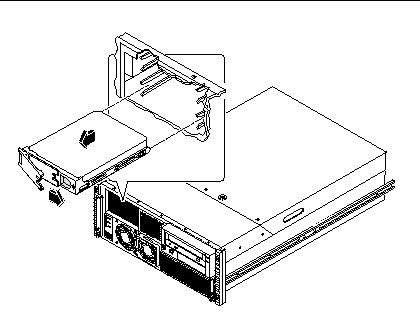
-
Swing the handle away from the drive until you feel the drive connector disengage from the backplane.
-
Holding the disk drive by the handle, slide it out of the drive bay.
-
Place the disk drive on an antistatic mat.
4.1.3 What Next
To install the disk drive, complete this task:
4.2 How to Install a Disk Drive
The system's disk hot-plug feature lets you install a disk drive without shutting down the operating system or turning off the system power. For more information, see your Sun Enterprise 220R Server Owner's Guide.
4.2.1 Before You Begin
Complete this task:
Note -
If the server is setup without a local graphics console, terminal, or monitor, you need to set up one of these options in order to issue software commands. See "About Setting Up a Console" on page 40 for further information.
4.2.2 What to Do
-
Prepare the system to receive the new disk drive.
The hot-plug installation procedure involves software commands for preparing the system prior to installing the disk drive. See your Sun Enterprise 220R Server Owner's Guide.
-
If you are not hot-plugging the disk drive, halt the operating system and turn off system power.
-
Push the disk drive latch to the right to release the disk drive handle.
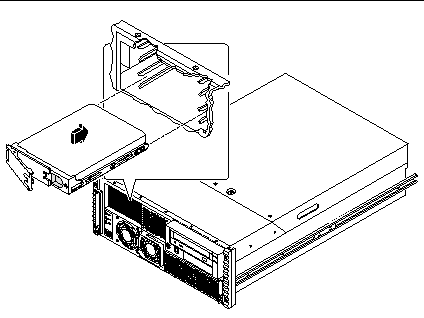
-
Align the disk drive to its drive bay.
Orient the drive so that the drive handle's hinge is on the left side of the drive bay.
Note -If you are reinstalling a drive that you previously removed, be sure to reinstall the drive in the same bay from which it was removed.
-
Holding the drive by its handle, fit the drive into the guide rails at the left and right of the drive bay.
-
Slide the drive into the bay until it lightly contacts the backplane.
-
Press carefully on the center of the drive and watch as the handle begins to close.
The drive handle begins to close as the drive engages its backplane connector.
-
Press the handle firmly toward the drive until the latch closes, securing the drive in the bay.
-
Close and lock the system doors.
Turn the keyswitch to the Locked position. This locks the system front doors, preventing access to the power supply(s) and to the disk drive(s).
-
If you are performing a hot-plug installation, complete the software part of the installation procedure.
For further information, see your Sun Enterprise 220R Server Owner's Guide.
4.2.3 What Next
When you are ready to restart the system, be sure to run OpenBoot Diagnostics tests to verify that the system functions correctly with the new parts you have just installed. For additional information, see:
You must also perform a reconfiguration boot so that your system is able to recognize any new device(s). For additional information, see:
4.3 How to Remove the Removable Media Assembly (RMA)
Note -
The removable media assembly can include a CD-ROM drive or a 4-mm tape drive.
4.3.1 Before You Begin
Complete these tasks:
4.3.2 What to Do
-
Disconnect the I/O power cable from the removable media assembly power connector.
See the illustration in Step 3 for the location of the RMA in the system.
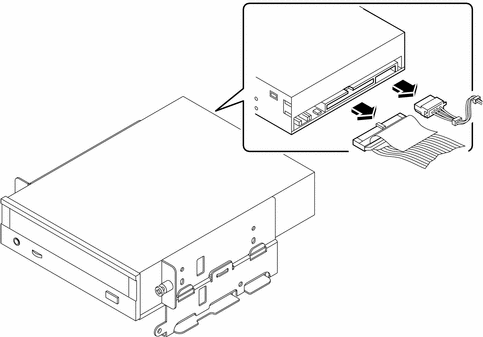
-
Disconnect the removable media SCSI cable from the removable media SCSI connector.
-
Pull off the plastic cover from the front of the removable media assembly.
Press down on the top of the plastic cover with your fingers until the tab on the top of the cover disengages from the chassis.
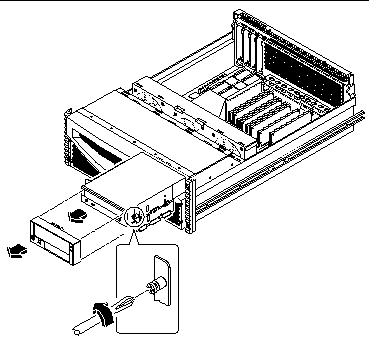
-
Loosen the two captive Phillips screws securing the removable media assembly to the chassis.
-
Slide the removable media assembly out of the system chassis.
-
Place the assembly on an antistatic mat.
4.3.3 What Next
For information about removing drives from, or installing drives into the removable media assembly, see
To replace the removable media assembly, complete this task:
4.4 How to Replace the Removable Media Assembly (RMA)
4.4.1 Before You Begin
Complete this task:
4.4.2 What to Do
-
Slide the removable media assembly into the system chassis.
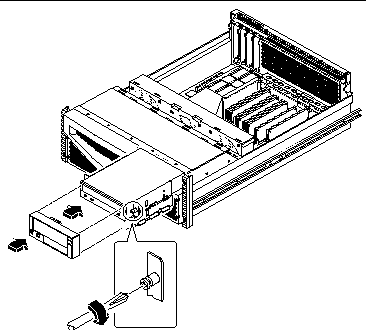
-
Tighten the two captive Phillips screws securing the removable media assembly to the system chassis.
-
If necessary, install one or more plastic filler panels into any empty drive bay openings in the RMA plastic cover.
Align the filler panel with its opening and press it into place.
-
Replace the RMA plastic cover.
Align the two posts on the bottom of the cover with the corresponding holes at the front of the chassis, and align the tab on the top of the cover with its corresponding hole and press down on the top of the center of the cover evenly until it snaps into place.
-
Reconnect the removable media assembly SCSI cable to the removable media SCSI cable connector.
The connector is keyed so that it connects in only one way. For information about cable connector locations, see "5.5 How to Connect the System Cables".
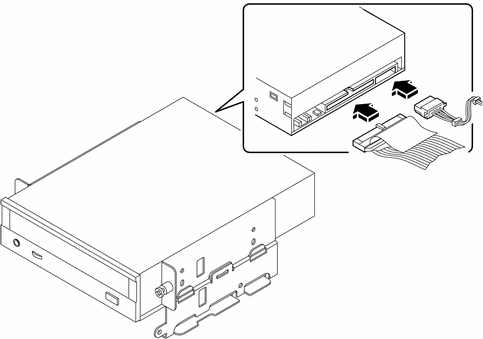
-
Connect the I/O power cable to the removable media assembly power connector.
The connector is keyed so that it connects in only one way.
4.4.3 What Next
To reassemble the system, complete this task:
4.5 How to Remove a CD-ROM or Tape Drive
4.5.1 Before You Begin
Complete these tasks:
4.5.2 What to Do
-
Remove the four screws securing the drive to the removable media assembly.
There are two screws on each side of the drive.
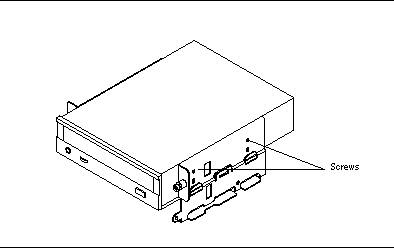
-
Slide the drive out from the front of its bay in the removable media assembly.
Push the drive from the back to start the removal process.
-
Place the drive on an antistatic mat.
4.5.3 What Next
To install the CD-ROM or tape drive, complete this task:
4.6 How to Install a CD-ROM or Tape Drive
4.6.1 Before You Begin
Know the configuration guidelines for installing removable media devices. For detailed information, see your Sun Enterprise 220R Server Owner's Guide.
Complete these tasks:
4.6.2 What to Do
-
If necessary, remove the plastic filler panel from the removable media assembly plastic cover.
On the back side of the RMA cover, push the filler panel retainer tabs inward to disengage the filler panel.
-
If you are replacing a defective drive, make sure that the jumper settings on the new drive match the settings on the old drive.
-
Slide the CD-ROM or tape drive into its drive bay.
Align the two screw holes on each side of the drive with the corresponding holes in each side of the drive bay.
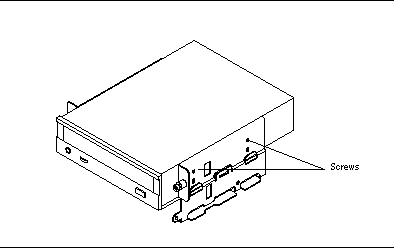
-
Insert and tighten the four flat-head Phillips screws that secure the drive in its bay.
There are two screws on each side that secure the drive in the RMA.
4.6.3 What Next
To reassemble the system, complete these tasks:
When you are ready to restart the system, be sure to run OpenBoot Diagnostics (OBDiag) tests to verify that the system functions correctly with the new parts you have just installed. For additional information, see:
You must also perform a reconfiguration boot so that your system is able to recognize any new device(s). For additional information, see:
- © 2010, Oracle Corporation and/or its affiliates
